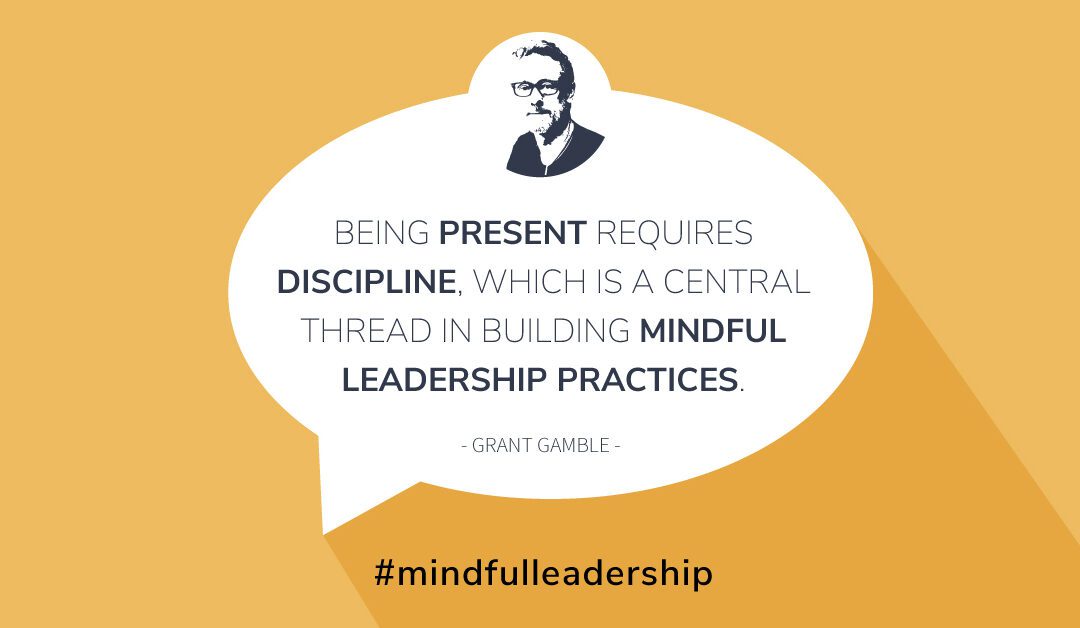 Being a Mindful Leader is not about having a yoga or meditation practice. Truly mindful leaders imbibe intentionality, awareness and an abiding presence. Exhibiting these characteristics, consistently, is incredibly hard amidst the cacophony of competing interests for your time and focus.
Being a Mindful Leader is not about having a yoga or meditation practice. Truly mindful leaders imbibe intentionality, awareness and an abiding presence. Exhibiting these characteristics, consistently, is incredibly hard amidst the cacophony of competing interests for your time and focus.
Being present requires discipline, which is a central thread in building mindful leadership practices.
The essential elements of your mindfulness practice can vary. Like many things, what suits one person may not suit another. I use the example of exercise: When you find an exercise activity that works for you, and that you enjoy, exercising becomes less of a chore and more of a joy. The same is true for establishing and preserving a mindful leadership practice.
Additionally, your practice needs to be built on strong fundamentals. Quality sleep, good nutrition and exercise are just three foundational elements that help accelerate a mindful leadership practice. I want to at least begin with an overview of those foundational elements.
THREE FOUNDATIONS FOR MINDFUL LEADERSHIP
 Sleep
Sleep
Sleep touches every facet of out lives, but is critical to mindfulness.
Researchers at UC Berkeley have recently shown that sleep deprivation negatively impacts the regions of the brain that help you understand people’s underlying motivations and intentions.
As one of my mentors taught me many years ago, understanding a person’s motivation and intentions provides important reference points when seeking to understand someone’s actions. These reference points can give you insights and perspective, and importantly promote empathy. Empathy is critical for the mindful leader.
So what does good sleep look like?
As the science of sleep has evolved, researchers have determined that a cumulative total of 49 to 56 hours a week is optimal. In other words 7-8 hours of sleep a night, on average, and if you miss some sleep try and supplement with a little extra when you can.
Short naps of 15 to 20 minutes can help ‘top up the tank’, but longer naps can create a ‘sleep hangover’ you don’t want.
Other fundamentals like avoiding caffeine later in the day, and watching screens (especially falling asleep to a screen) can inhibit falling sleep and achieving good quality ‘deep sleep’.
And the basics of a great mattress, quality pillow, the ability to create a dark and cool sleeping environment are obviously essential. I go deeper into these factors in a separate article, “Improve Your Life by 1/3 Today”.
 Good Nutrition
Good Nutrition
Science and anecdotal evidence exist to support many different diets and nutritional philosophies. I have known people who have pursued a vegan diet and their health and vitality have deteriorated. I have similarly known people who have gone vegan and flourished. Much like exercise, what works for one person may not work for another.
Amidst all the cacophony around diet and nutrition, I believe there are a few basic tenets.
The first tenet of healthy eating is to try and eat the least processed food possible. The more food is processed, and refined; the more additives and ingredients it has; the more of those ingredients you don’t recognize, or can’t pronounce; the less value that food typically has for you.
In other words, an apple is better than apple sauce, apple sauce is better than apple juice, apple juice with fiber is better than apple juice without fiber, and so on. What other ingredients get added to that apple sauce or juice also significantly impact the overall value. That can include sugar, preservatives, emulsifiers and much more.
The second tenet is eating as cleanly as possible. This includes trying to eat organic, non-GMO food where possible. Given the amount of food we do not prepare ourselves this can be difficult to control, but if you have the option to eat cleaner, try and make this positive choice where possible.
This leads to the third tenet, and that is preparing more of your own meals. Not only do you control what goes in to that meal, but you control how it’s prepared.
Not to mention that cooking can be great quality time with your partner or other family members. And what a joy to make and enjoy good food with and for your family or friends.
The third tenet of good nutrition is mindful eating. This means eating consciously (ideally not while watching TV or being on your phone), taking your time to truly chew and appreciate your food and paying attention to when you eat.
Just the act of slowing down and being conscious in your eating will lead to you eating less food and becoming more aware of what you’re eating.
The other aspects of mindful eating are when and where you eat. Your body has natural rhythms and eating within its active cycles makes sense. Eating late at night when your body is slowing down and looking to focus on rejuvenation, and not digestion, makes good sense and is supported by substantial science. With respect to where to eat, eating in front of the TV is obviously not as conducive to conversation and mindful eating as eating at the dinner table.
I am barely scratching the surface here. In a series of articles called “The Food Dilemma”, I attempt to address some of the conflicting nutritional advice we are besieged with on a daily basis, and make some sense of the multitude of strategies out there to help you get the most out of your food.
Exercise
The scientific and medical communities generally align on the benefits of regular exercise. This alignment is based on the insurmountable body of evidence supporting the case for moving your body regularly, with some degree of intensity. So if you’re a regular exerciser and feel you are gleaning the many benefits of an established fitness regime, you may want to skip this part. For those of you that struggle, or consider regular exercise elusive, here are a few of my thoughts.
Regardless of the undeniable benefits of exercise, they don’t make it any easier to subscribe to exercise if you haven’t found a form of exercise you enjoy or can sustain.
Having spent much of my career in the fitness and wellness industry, I have gained some insights from many successes and failures I have both championed and witnessed.
The best advice I can give anyone trying to begin an exercise routine is to keep it simple. The foundation of a sustainable exercise routine is finding activities you enjoy, or at least don’t hate; activities that are conveniently located and fit into your schedule.
For example, regardless of the touted benefits of running if you truly despise running, don’t run. Get creative and explore activities that you think might be fun, or that you could do with a friend. To me, walking is one of the simplest and most accessible forms of exercise, but doing it with a friend (or ‘man’s best friend’) will likely make it more fun and help you keep it up. Our daughter is not an ‘exerciser’, but she loves taking our dogs for a walk up our laneway and gets a great workout (they’re not particularly well behaved) in the process.
Again, I go deeper into exercise in a set of articles entitled “Baby Steps”.
The First Step Toward Mindful Leadership
These three foundational elements can help energize your mindfulness practice, set a great example for your team, and influence the way you lead. Caring and connecting with your team members also magnifies your ability to impact the growth and performance of your company as a mindful leader.
Creating that sense of caring and connection fundamentally requires you to be truly present in your interactions with your team and stakeholders.

Your presence in a conversation, meeting, or exchange, is palpable.
When you’re truly present in the interaction, connected visually and listening intently, you are far more capable of seeing the nuance, interpret the body language, and pick up on the subtle cues being projected.
Also people appreciate your true presence. They intrinsically, and cognitively, appreciate that you are listening, hearing and being present for them.
Often times I find myself getting distracted in an interaction with a team member and just like in meditation I need to bring my focus back. What has popped up on your screen, or that nagging thought about an outstanding task, pulls your attention away from the interaction. Like many driven leaders, I had selfishly convinced myself that I can split my attention between competing activities, but science would counter that notion.
Obviously, we are capable of doing two tasks at once; one of my favorite examples is ‘walking meetings’. But this involves two very different cognitive resources. When we are trying to simultaneously process words, for example in a conversation and on a screen, a bottleneck occurs and either or both areas of focus suffer.
Maintaining focus, or presence, is much like a muscle. You need to exercise it to make it stronger.
This is why Mindful Meditation is a foundational element of the mindful leader’s toolbox. Mindful Meditation involves having your thoughts focused on the present moment.
You can place your attention on your breath, or an object of thought. The critical thing to acknowledge is that you will lose focus, but when you drift off you need to bring your focus back to your breath, or the object of your attention, and build your ability to maintain this focus. Mindful Meditation is very different from Transcendental Meditation, which involves being aware, without an object of thought.
Cultivating this ability to focus will benefit you in your role as a leader and in your relationships with friends and family. As I have developed my meditation practice
I have found many benefits beyond the increased ability to focus. Meditation can also help you reduce stress and anxiety, improve your quality of sleep, improve memory, increase the regulation of emotion, and improve the ability to get perspective1.
Personally it has taken me a long time to fully appreciate the many benefits of a Mindful Meditation. With all the competing forces for our time, creating the discipline to establish a practice is tough. I have found the key is taking baby steps.
 Find a time, first thing in the morning, or after the kids have gone to bed, or even on your lunch break, where you can take just a few minutes to shift your focus inward. You can build on those smaller increments of time and ideally increase your practice to ten, fifteen, or more minutes daily as your mindful muscle builds.
Find a time, first thing in the morning, or after the kids have gone to bed, or even on your lunch break, where you can take just a few minutes to shift your focus inward. You can build on those smaller increments of time and ideally increase your practice to ten, fifteen, or more minutes daily as your mindful muscle builds.
When developing your practice, you need a space where you won’t be interrupted and that’s free of distractions. Get comfortable, ideally sitting up, and focus initially on your posture. Good posture is fundamental to a solid practice. Imagine a force drawing your body up into its fullest height. Your shoulders are relaxed and eyes are soft, or closed.
I started my practice focusing on my breathing. It was an easy thing I could bring my attention to and I found that it helped dissolve stress when I breathed consciously and rhythmically. I have played with various lengths of breath in and out, for example a steady breath in for four slow counts, then a steady breath out for four slow counts. I have also tried breathing in through the nose and out through the mouth and varying the breath length.
There is no perfect formula, but I have benefited most from using Ujjayi Breath, which is used in Ashtanga and Vinyasa yoga practices. Ujjayi means “to conquer” or “to be victorious”.
I certainly feel it helps me conquer my restless mind. Ujjayi Breath is where you breathe through your nose and contract your throat to create resistance to the breath. Ujjayi Breath is often called “Ocean Breath” and when I feel I am doing it well it sounds like the rise and retreat of waves on a beach.
I believe starting with a Mindful Meditation practice is a great way to move towards more Mindful Leadership, while simultaneously improving your health and performance in many aspects of your life.
Mindful Leadership doesn’t necessarily start with Mindful Meditation, but this is one common denominator I have come to see as a foundation stone of the Mindful Leader.
Note: Read more on the journey toward Mindful Leadership in Grant’s eBook, “Next Steps Toward Mindful Leadership.”
1 “Mindfulness practice leads to increases in regional brain gray matter density.” Britta K. Hölzel: Psychiatry Res. 2011 Jan 30; 191(1): 36–43

Get In Touch
Send an email via the form below or call to set up a free consultation.
Charlottesville, Virginia
434.996.5510
Find Grant on LinkedIn:


 Sleep
Sleep Good Nutrition
Good Nutrition